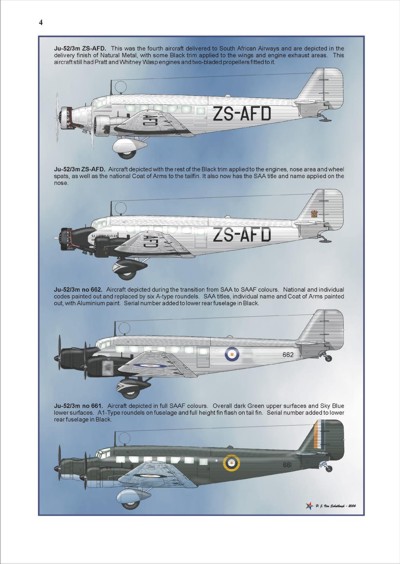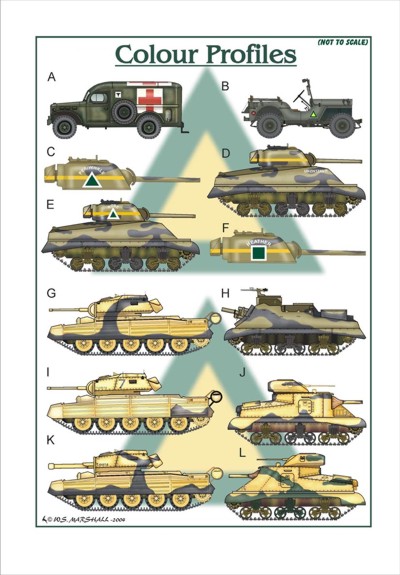Once again I have the pleasure of reviewing a book produced in South
Africa. In the latest team effort, the authors have continued their
practice of combining aircraft, armour and regalia sections in a
single volume. They have, however, changed their printing process,
in that entire book is now produced digitally. This latter change
was undertaken to accommodate the small number of books produced,
which became prohibitively expensive using conventional printing
approaches. This change has, however, not affected the quality in
any manner. Indeed, if anything, the illustrations appear sharper
and better defined than in previous volumes.
The authors also point out that this change will facilitate the
future printing of volumes devoted to a single type. As such, this
volume is the last of the series dealing with a number of topics.
 The
coverage of the JU 52 and Ju 86 is very welcome, as previous
documentation on these aircraft in SAAF service has been extremely
limited. The section on the JU 52 covers the acquisition 15 aircraft
by the South African Airways in the period of 1934 to 1938, the
various schemes used by this carrier and the official names bestowed
on these aircraft e.g. ZS-AFA “Jan van Riebeeck”. Of particular
interest are the details of the Pratt and Whitney “Wasp” engined
aircraft, those powered by the more powerful Pratt and Whitney
“Hornet” engines, in that the wing-mounted engines in the former
case display the characteristic outward splay, whereas on the latter
aircraft, the engines are mounted parallel to the fuselage. This
would surely, not the easiest conversion to undertake! The use of
these aircraft by the SAAF is well covered, and details are provided
of the various schemes e.g. initial overall aluminium scheme and
final dark green and sky blue scheme. An added bonus is the
inclusion of the 12 captured JU 52’s in service with the SAAF. These
facets are covered by numerous photos, many of which the reviewer
has not seen before, as well as excellent profiles (side, bottom and
top). What more could a modeller ask for?
The
coverage of the JU 52 and Ju 86 is very welcome, as previous
documentation on these aircraft in SAAF service has been extremely
limited. The section on the JU 52 covers the acquisition 15 aircraft
by the South African Airways in the period of 1934 to 1938, the
various schemes used by this carrier and the official names bestowed
on these aircraft e.g. ZS-AFA “Jan van Riebeeck”. Of particular
interest are the details of the Pratt and Whitney “Wasp” engined
aircraft, those powered by the more powerful Pratt and Whitney
“Hornet” engines, in that the wing-mounted engines in the former
case display the characteristic outward splay, whereas on the latter
aircraft, the engines are mounted parallel to the fuselage. This
would surely, not the easiest conversion to undertake! The use of
these aircraft by the SAAF is well covered, and details are provided
of the various schemes e.g. initial overall aluminium scheme and
final dark green and sky blue scheme. An added bonus is the
inclusion of the 12 captured JU 52’s in service with the SAAF. These
facets are covered by numerous photos, many of which the reviewer
has not seen before, as well as excellent profiles (side, bottom and
top). What more could a modeller ask for?
The JU 86 must rank as one of the most aesthetically pleasing
aircraft of its period. Unbeknown to many, SAA acquired 18 of these
aircraft, making it the largest civilian operator of the type. Of
particular interest is that one of these aircraft operated by SAA
was a Ju 86K-1 bomber, complete with “dustbin turret” and bomb
racks. The operation of such a type by a peace time civilian
operator gives an inclination of the dark clouds looming on the
horizon. The use of these aircraft in their maritime patrol role, as
well as their activities as bombers in the Abyssinian campaign in
East Africa in 1941 are well described and supported by copious
photos and 3 view profiles.
The next section of this book again typically deals with a more
modern aspect of SAAF history, in this case the Canadair CL-13B
Sabre Mk6. These Sabres, powered by the powerful /275 lb thrust
Orenda jet engine, and having the rather unique combination of the
wider “6-3” wing with leading edge slats, were reported to be the
most agile of all Sabre variants. The service of these aircraft,
from their acquisition in 1956 to their retirement in 1980 is well
documented. Numerous schemes are covered, including the livery
scheme with commonwealth Springbok roundels similar to that used in
Korea, the change to the 5 pointed “castle” roundel in 1957, the
special markings used by No.1 and 2 Squadrons, including a striking
day-glo orange variant, to the final camouflage schemes as used by 1
Squadron (prior to their transition to the Mirage F1AZ) and the
final days with 85 Advanced Flying School. This section is rounded
off by a very nice walk-around of two surviving Sabres in South
Africa. As such, this section will be a great help to those wanting
to model any one of these aircraft, and will excellently complement
the Leading Edge decal set for these SAAF Sabres.
 Having
gained an increasing interest in armour, thanks to the release of
Tamiya’s excellent 1/48 kits, I was particularly pleased to see the
section on 6 SA Armoured Division in North Africa, as one of the
vehicles described is the Sherman. Particularly useful is the
description of the camouflage scheme used, the types of pennants
used for identification, as well as details of several personalised,
such as “Rose”, “Periwinkle” or “Umzintzanti”. These aids will
surely help this, and other, devout aircraft modeller(s) to find
more enjoyment in building a few “targets”. This discourse also
provides a useful indication of the number of different types of
tanks used by the SADF in North Africa, which included Sherman,
Crusader, Grant, Priest and Stuart.
Having
gained an increasing interest in armour, thanks to the release of
Tamiya’s excellent 1/48 kits, I was particularly pleased to see the
section on 6 SA Armoured Division in North Africa, as one of the
vehicles described is the Sherman. Particularly useful is the
description of the camouflage scheme used, the types of pennants
used for identification, as well as details of several personalised,
such as “Rose”, “Periwinkle” or “Umzintzanti”. These aids will
surely help this, and other, devout aircraft modeller(s) to find
more enjoyment in building a few “targets”. This discourse also
provides a useful indication of the number of different types of
tanks used by the SADF in North Africa, which included Sherman,
Crusader, Grant, Priest and Stuart.
The final section on uniforms and regalia deals with Scottish
regiments in South Africa, tracing their routes back to the
Anglo-Zulu war in Natal in the 1800’s. Details are provided of the
Transvaal Scottish, the Cape Town Highlanders and the Witwatersrand
Rifles.
All in all, this is a superb volume and should please any SAAF/SADF
devotee. As such, we can look forward to future volumes which will
cover the Spitfire in SAAF service during WW2, the early years of
the Mirage III, as well as the 6 SA Armoured Division in Italy. As
pointed out above, all of these will be now be dealt with in single
discrete volumes.
Copies of this limited edition print are available directly from the
authors at:
mechinf@netactive.co.za.
Home | What's
New | Features
| Gallery |
Reviews | Reference
| Forum
| Search